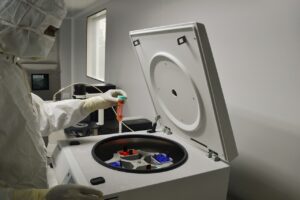A recent study published in Clinical Lymphoma, Myeloma, and Leukemia offers new hope for older adults with myelofibrosis (MF), suggesting that allogeneic hematopoietic stem cell transplantation (allo-HCT) remains a viable, potentially curative option—even for patients aged 65 and above.
Comparable Survival Across Age Groups
The study, reported by Rare Disease Advisor, assessed 856 patients with MF who underwent allo-HCT, including 259 individuals aged 65 or older. Notably, two-year overall survival rates were similar between older and younger patients: 61.8% for those over 65, compared to 68.3% for younger counterparts. The median overall survival was not reached during the study, highlighting the durability of benefit in both age groups.
While older patients experienced slightly lower two-year disease-free survival (DFS) rates (33.3% vs. 38.7%) and a marginally shorter median DFS (6.02 vs. 6.5 months), age 65 and above was the only independent predictor of inferior DFS. Importantly, age did not influence other critical outcomes such as relapse rates, nonrelapse mortality, acute or chronic graft-vs-host disease (GVHD), or GVHD-free/relapse-free survival.
Risk Factors and Individualized Strategies
The authors identified several key predictors of worse post-transplant outcomes. Higher comorbidity burden (HCT-CI score of 3 or higher), use of antithymocyte globulin (ATG), mismatched unrelated donors, and use of bone marrow grafts were all linked to reduced survival or DFS. Prior splenic radiation and ATG use, in particular, significantly impacted overall survival.
These findings underscore the need for personalized transplant strategies for older MF patients. Selecting optimal donors, minimizing comorbidity burden, and carefully weighing pre-transplant therapies can improve outcomes. The authors also suggest that adjunctive therapies such as ruxolitinib or donor lymphocyte infusions may help mitigate relapse risk in older recipients.
Clinical Implications
Historically, age has been a barrier to potentially curative therapy for MF, but this study challenges that paradigm. The results indicate that, with careful patient selection and individualized risk assessment, allo-HCT can provide meaningful survival benefits for older adults—comparable to those seen in younger patients.
Additionally, the study’s insights into risk factors such as donor match, comorbidities, and pre-transplant treatments offer valuable guidance for clinicians considering allo-HCT for their older MF patients.
Conclusion
Allo-HCT should not be ruled out solely based on age for patients with myelofibrosis. With a nuanced approach that accounts for health status, donor compatibility, and additional risk factors, select older patients can achieve survival outcomes similar to younger recipients. This research paves the way for expanded treatment options and renewed optimism for older adults facing this challenging disease.








